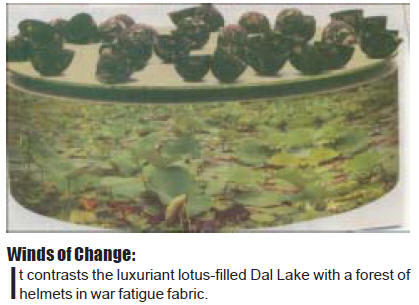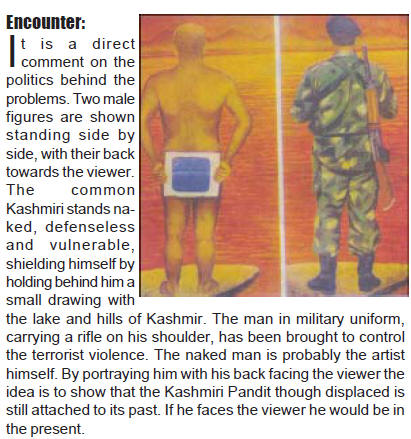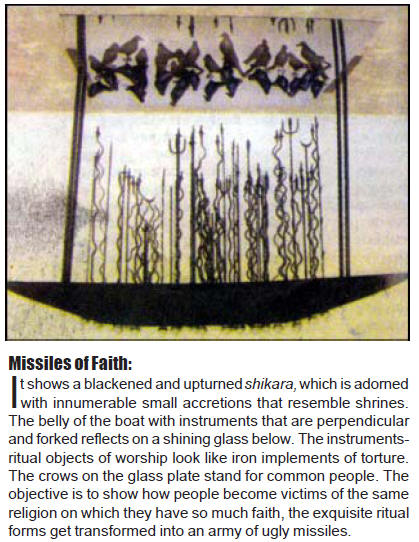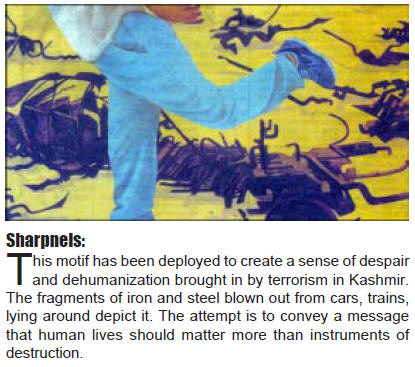Veer Munshi relocates his Exile
by Kuldeep Raina
 Exile
is a profound
tragedy. Those who do
not experience it
cannot feel its pain. It shatters
the victim. Fear, Displacement,
Marginalisation, continued
Genocide, Rootlessness, Alienation,
Social disintegration, deculturation
all accompany genocide. Exile
is a profound
tragedy. Those who do
not experience it
cannot feel its pain. It shatters
the victim. Fear, Displacement,
Marginalisation, continued
Genocide, Rootlessness, Alienation,
Social disintegration, deculturation
all accompany genocide.
There are two responses
from the civil society of the
victimised community. Sensitive
sections give meaning to the exile,
regenerate the community
and prepare it for retrieving what
has been lost. Hedonist segment
advocates accepting exile as a
fait accompli and to justify the
compromises invents its own
politics based either on betrayal
or incomprehension. One cannot
be neutral to one's own genocide
and destiny. In responding
to genocide the victim does not
have an option of remaining 'objective',
of course he can be rational.
His strong commitment to
fight genocide is the key to his
survival. An artist has to survive
as well. In a milieu where the
victim's politics does not fall in
'political correctness' an artist, a
creative one, has a greater challenge
i.e. to combine sheer commercialism
with intellectual concern
to maintain visibility on the
genocide.
Veer Munshi,
a famed
painter, who was displaced from
Kashmir alongwith other members
of his community in 1990,
has shown how a responsible
artist can serve the twin concerns -
addressing the genocide
and perpetual exile, besides the
larger commitment to the issues
faced by the minorities all over
the world and the victims of
unjust wars (waged either for
ideology or for imperialist expansion).
Minorities have been
victims of the same phenomenon -
religious intolerance and
cultural/ethnic exclusivism.
Erosion of the state, where the
state is either unable to defend
the minority or is apathetic, too
has contributed to the
marginalisation of minorities,
displaced as a result of ethniccleansing.
In his first exhibition in early
nineties, Veer Mushi's focus
was - the process and the tragedy
of displacement of his owncommunity.
It has been a long
journey since then. Munshi has
witnessed the helplessness of
the people in New York, in
London, in West Asia, and in
Mumbai.
His latest exhibition titled
'Encounter' - jointly
promoted
by Art Alive Gallery and the Visual
Arts Gallery, was on display
at India Habitat Centre on 25-30
August. He describes his journey
from 'focus on personal
genocide' to 'larger genocide of
peoples' affected by terrorism' as
his
commitment to social
responsibility.
He attributes his
sensitivity to the experience of
his own history. Munshi asks
the people to remain vigilant.
Munshi's works on display
combine three themes:
Division -
ideological, political. Belief
and identity divide the communities,
Partition - which
is
the geopolitics of this divisionin
the Indian subcontinent, West
Asia and elsewhere, Migration -
is the fallout of partition
where millions of refugees are
battling the marginalisation and
rootlessness. Munshi has used
the river to show the divide because
it evokes nostalgia.
It is a
metaphor for
territorial
division.
He comments that 'Division'
is a malaise threatening the
ordinary citizens in every country.
Silence of weaver:
Shikara, here as in Missiles
of Faith,
has been used as a
meaningful metaphor not to remind
us of Kashmir's beautiful
Lakes but to transport the viewer
across the shores to death and
destruction. Here a Shikara is
hung up and laid to rest on a wall.
It is adorned with profile of AK-
47 to convey that the beautiful
paradise now lived under constant
fear of terrorism.
Partition
Eye To Eye:
Two men crouch on either of
the border
Dialogue: Two large dogs
confront each other across the
border.
Gandhi vs Gandhi: It is
shown that only Gandhi was
against the partition.
The divide in each is shown
with a river. The river is shown
as symbol of divide because it
invokes nostalgia.
Will there Redemption of
Peace:
It shows a huge wooden drum
with a flock of white pigeons.
Below the circumference is the
face of a Kashmiri, middle-aged
braving unfriendly weather but
who still retains hope.




Source: Kashmir
Sentinel
| 